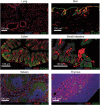The influence of AHR on immune and tissue biology
- PMID: 39242971
- PMCID: PMC11473696
- DOI: 10.1038/s44321-024-00135-w
The influence of AHR on immune and tissue biology
Abstract
The aryl hydrocarbon receptor is a ligand dependent transcription factor which functions as an environmental sensor. Originally discovered as the sensor for man made pollutants such as 2,3,7,8-Tetrachlorodibenzo-p-dioxin (TCDD) it has recently gained prominence as an important mediator for environmental triggers via the diet or microbiota which influences many physiological functions in different cell types and tissues across the body. Notably AHR activity contributes to prevent excessive inflammation following tissue damage in barrier organs such as skin, lung or gut which has received wide attention in the past decade. In this review we will focus on emerging common AHR functions across cell types and tissues and discuss ongoing issues that confound the understanding of AHR physiology. Furthermore, we will discuss the need for deeper molecular understanding of the functional activity of AHR in different contexts with respect to development of potential therapeutic applications.
Keywords: Aryl Hydrocarbon Receptor; Barrier Organs; Cytochrome P4501; Intestinal Epithelium; Tissue Repair.
© 2024. The Author(s).
Conflict of interest statement
The authors declare no competing interests.
Figures


References
-
- Accioli CAF, da Silva MS, Santos B, Rodrigues CR (2023) Aryl hydrocarbon receptor as a therapeutical target of environmentally induced skin conditions. Mol Pharmacol 103:255–265 - PubMed
-
- Bobonich M, Gorelick J, Aldredge L, Bruno MJ, DiRuggiero D, Martin G, Tallman AM, Gold LS (2023) Tapinarof, a novel, first-in-class, topical therapeutic aryl hydrocarbon receptor agonist for the management of psoriasis. J Drugs Dermatol 22:779–784 - PubMed
-
- Bock KW (2020) Aryl hydrocarbon receptor (AHR)-mediated inflammation and resolution: Non-genomic and genomic signaling. Biochem Pharmacol 182:114220 - PubMed
Publication types
MeSH terms
Substances
Grants and funding
LinkOut - more resources
Full Text Sources
Miscellaneous

